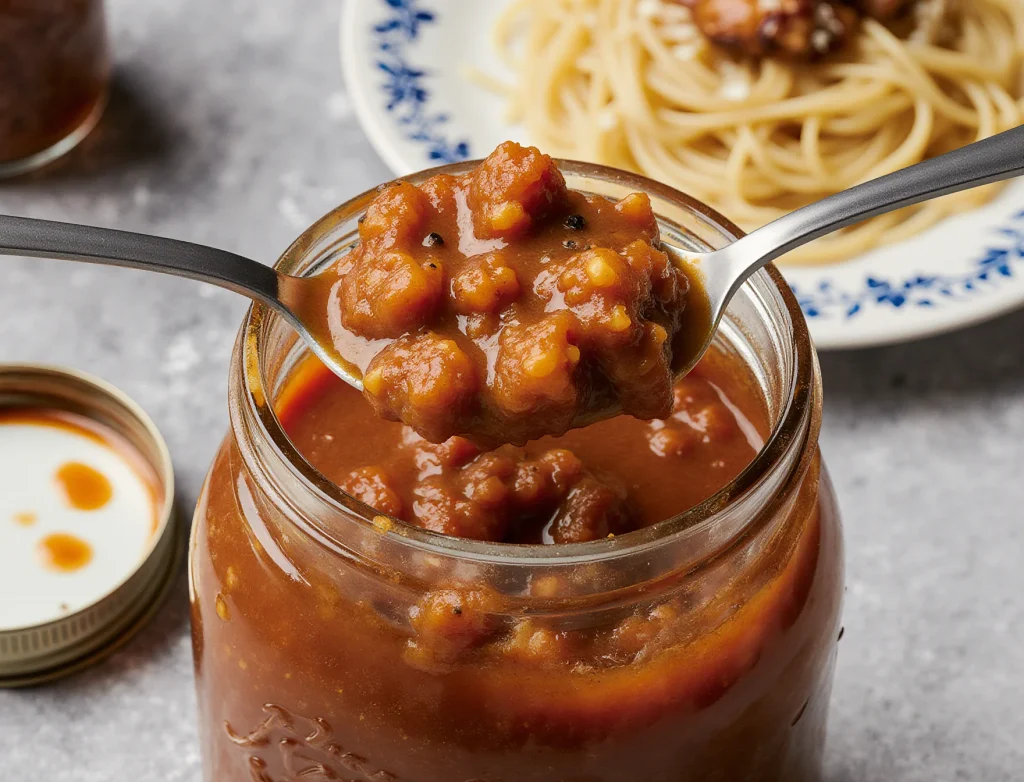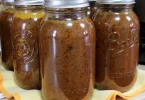
There’s something timeless about a pot of spaghetti sauce simmering on the stove — the scent of fresh tomatoes, basil, and garlic filling your kitchen. Maybe it reminds you of family dinners, of someone stirring sauce slowly while music played in the background, or of long summer days when the garden overflowed with ripe tomatoes.
Canning spaghetti sauce isn’t just about saving food. It’s about preserving that feeling — the warmth, the flavor, the love that comes from making something by hand. Every sealed jar is a memory of the harvest, ready to open when the cold months arrive.
If you’ve ever wished you could keep that garden-fresh flavor all year long, this guide will walk you through everything you need to know. You’ll learn how to make, prepare, and safely can your own homemade spaghetti sauce, using simple ingredients and methods that even beginners can master.
What Makes Canning Spaghetti Sauce So Special
When you can your own sauce, you’re doing more than cooking. You’re reclaiming control over what’s on your table. You know exactly what’s inside your food — no preservatives, no hidden sugars, no unpronounceable additives. Just pure, wholesome ingredients and the taste of real tomatoes.
But the beauty of canning spaghetti sauce goes beyond nutrition. It’s an act of creativity and self-sufficiency. You take simple ingredients and transform them into something rich and satisfying — a sauce that’s ready whenever you need a quick meal or a homemade touch.
Here’s why people all over the world love canning their own sauce:
- Flavor Control: You decide how thick, spicy, or herby it is.
- Cost Savings: A big batch costs less than store-bought jars.
- Less Waste: Preserve your garden harvest or bulk tomato buys.
- Sustainability: Fewer cans, fewer trips to the store.
- Sentimental Value: Every jar holds a bit of your care and effort.
Whether you’re a seasoned home canner or a complete beginner, this process brings a quiet kind of satisfaction — one that connects you to simpler times and healthier choices.
Understanding the Basics of Canning Spaghetti Sauce
Before diving into the recipe, it’s essential to understand how canning works and why safety matters. When you’re sealing food for long-term storage, you must control acidity and temperature to prevent spoilage and bacteria growth.
The Two Main Methods
There are two safe ways to can spaghetti sauce, depending on your ingredients:
- Water Bath Canning – Best for tomato-only sauces or high-acid recipes (no meat).
- Pressure Canning – Required if your sauce includes low-acid ingredients like meat, onions, or vegetables in large amounts.
Why Acidity Matters
Tomatoes are naturally acidic, but modern hybrid varieties tend to be less so. To ensure food safety, you must acidify your sauce before canning. The most reliable way is to add bottled lemon juice or citric acid to each jar.
| Additive | Amount per Quart | Amount per Pint |
|---|---|---|
| Bottled Lemon Juice | 2 tablespoons | 1 tablespoon |
| Citric Acid | ½ teaspoon | ¼ teaspoon |
This simple step makes your sauce safe for water bath processing and prevents harmful bacteria such as Clostridium botulinum from developing.
Ingredients You’ll Need
Here’s the full ingredient list for a batch that yields approximately 6 quarts of sauce — perfect for 6–8 standard quart jars.
| Ingredient | Amount | Notes |
|---|---|---|
| Fresh tomatoes (Roma or plum) | 20 lbs | Use firm, ripe tomatoes for the best texture |
| Olive oil | ¼ cup | Optional for flavor; omit if water bath canning |
| Onions (chopped) | 2 cups | Adds depth and sweetness |
| Garlic (minced) | 6 cloves | Enhances aroma |
| Tomato paste | 6 oz | Thickens the sauce naturally |
| Fresh basil (chopped) | ½ cup | Substitute 2 tbsp dried |
| Oregano | 2 tbsp | Classic Italian seasoning |
| Sugar | 2 tsp | Balances acidity |
| Salt (canning or kosher) | 2 tbsp | Avoid iodized salt |
| Lemon juice (bottled) | See above chart | Ensures safe acidity |
| Water or tomato juice | As needed | For consistency adjustments |
Ingredient Tips
- Choose Roma or plum tomatoes — they have fewer seeds and less water.
- Avoid butter or cheese in the canning process; add these when serving.
- Fresh herbs can be used, but don’t overload — they may affect acidity.
- If using olive oil, limit it; too much can reduce shelf stability.
Step-by-Step Guide to Canning Spaghetti Sauce
Step 1: Prepare the Tomatoes
- Wash tomatoes thoroughly.
- Bring a large pot of water to a boil.
- Blanch tomatoes by placing them in boiling water for 45–60 seconds.
- Transfer immediately to ice water.
- Peel skins (they’ll slip right off), core, and chop.
You can also run peeled tomatoes through a food mill to remove seeds and create a smoother texture.
Step 2: Cook the Sauce
In a large stockpot:
- Sauté chopped onions and garlic in olive oil (optional).
- Add the prepared tomatoes, tomato paste, herbs, sugar, and salt.
- Stir well and bring to a gentle simmer.
- Let the sauce cook uncovered for 45 minutes to an hour, stirring occasionally.
The sauce will reduce and thicken as it cooks. Adjust the consistency by adding tomato juice or water if needed.
Step 3: Sterilize Jars and Lids
Sterilization is crucial for safe canning.
- Wash jars, lids, and rings with hot, soapy water.
- Place jars in a large pot of simmering water for 10 minutes.
- Keep them hot until you’re ready to fill them.
- Boil lids briefly to soften the sealing compound.
Step 4: Fill the Jars
- Add lemon juice or citric acid to each jar before filling.
- Carefully ladle the hot sauce into jars, leaving ½ inch of headspace.
- Remove air bubbles with a clean utensil.
- Wipe jar rims with a damp cloth.
- Place lids on and screw bands to fingertip tightness.
Step 5: Process the Jars
Water Bath Canning (for high-acid sauces)
- Place jars on a rack inside the canner, making sure they’re covered with at least one inch of water.
- Bring to a gentle boil.
- Process pint jars for 35 minutes and quart jars for 40 minutes.
- Adjust for altitude if necessary.
Pressure Canning (for meat or low-acid ingredients)
- Process at 10 PSI for 20–25 minutes, depending on your canner type.
- Always follow your canner manufacturer’s instructions.
Step 6: Cool and Store
- Turn off heat and let jars rest for 5 minutes before removing.
- Place on a towel-lined counter and let cool undisturbed for 12–24 hours.
- Listen for the “ping” sound — it means your jars have sealed properly.
- Check the seals: the lid should be concave and not pop when pressed.
- Label jars with date and batch name.
Store in a cool, dark pantry. Properly sealed jars can last up to 18 months.
Tips for Success
- Always use bottled lemon juice — it has consistent acidity, unlike fresh lemons.
- Don’t skip headspace — jars may leak or fail to seal if overfilled.
- Use canning-specific jars (like Ball or Kerr). Regular glass jars may crack under heat.
- Avoid adding meat or oil to sauces unless you’re pressure canning.
- Check jars before use — discard any with broken seals or discoloration.
Safety Considerations
Canning is safe when done correctly, but mistakes can lead to spoilage. Here are the golden rules:
- Never can low-acid sauces in a water bath. Always use a pressure canner for anything with meat or veggies.
- Follow tested recipes. The National Center for Home Food Preservation provides trustworthy data.
- Use new lids each time. Old lids may not seal properly.
- Avoid creative shortcuts. Safety is more important than speed.
- Check your seals. If a lid flexes or pops, refrigerate immediately and consume within a week.
Variations to Try
Canning spaghetti sauce doesn’t mean every jar must taste the same. Try these versions to add excitement to your pantry.
1. Classic Italian Herb Sauce
- Add extra basil, oregano, and a dash of crushed red pepper.
- Perfect for pasta, lasagna, or baked ziti.
2. Roasted Garlic & Tomato
- Roast garlic cloves in the oven before adding them for a deeper flavor.
3. Garden Vegetable Blend
- Include bell peppers, zucchini, or carrots (requires pressure canning).
4. Spicy Arrabbiata
- Add chili flakes or fresh hot peppers for a bold, fiery sauce.
5. Rustic Chunky Tomato Sauce
- Keep the tomatoes diced instead of pureed for a hearty texture.
Nutritional Breakdown
| Serving (½ cup) | Amount |
|---|---|
| Calories | 80–90 |
| Protein | 2 g |
| Fat | 1 g |
| Carbohydrates | 18 g |
| Fiber | 3 g |
| Vitamin C | 25% DV |
| Lycopene | High |
| Sodium | Varies by salt content |
Homemade sauce is naturally lower in sugar and preservatives than most store-bought brands. You get real nutrients, real freshness, and real flavor.
Troubleshooting Common Problems
| Issue | Possible Cause | Solution |
|---|---|---|
| Sauce too thin | Overripe tomatoes or not cooked long enough | Simmer longer or add tomato paste |
| Lids didn’t seal | Dirty rims or incorrect headspace | Reprocess within 24 hours |
| Sauce separation | Natural tomato layering | Shake before use |
| Off odor | Spoiled product or air leak | Discard immediately |
| Foaming | Overcooked sauce or vigorous boiling | Stir gently and skim foam |
Frequently Asked Questions (FAQ)
Q1. Can I use any tomato variety?
Yes, but Roma or paste tomatoes work best because they’re meaty and less watery.
Q2. Can I add meat to my sauce?
Only if you’re using a pressure canner. Water bath canning is not safe for meat-based sauces.
Q3. How long will canned spaghetti sauce last?
Properly sealed jars stored in a cool, dark place will last up to 18 months.
Q4. Why do I need to add lemon juice?
It ensures safe acidity levels for long-term preservation.
Q5. Can I reuse jars and lids?
Jars, yes. Lids, no. Always use new lids for a reliable seal.
Q6. How do I know if my sauce went bad?
Signs include bulging lids, cloudy sauce, bubbles, or unpleasant odors.
Q7. Do I need to peel the tomatoes?
Yes. Skins can turn bitter and affect texture.
Why You’ll Love Making Your Own Canned Spaghetti Sauce
Every time you open a jar of homemade sauce, you’ll taste more than tomatoes. You’ll taste effort, patience, and care. You’ll remember the day you made it — the chopping, the simmering, the sealing — and how proud you felt lining those jars on your pantry shelf.
Canning spaghetti sauce is a tradition that connects you to generations of home cooks who found joy in making things from scratch. It’s a small act of self-reliance that brings big rewards — healthier food, meaningful memories, and the simple satisfaction of creating something lasting.
Conclusion: Preserve What Matters
When you make and can your own spaghetti sauce, you’re not just preparing food; you’re preserving love, heritage, and flavor. Each jar becomes a reminder that the best things in life are homemade.
Whether you grow your own tomatoes or buy them at the market, this process transforms simple ingredients into something extraordinary. It’s a way of bottling sunshine, of holding onto summer even when snow falls outside your window.
So go ahead — grab those tomatoes, roll up your sleeves, and start canning spaghetti sauce today. A little effort now will reward you with months of hearty, homemade meals and the deep satisfaction that comes from doing it yourself.
Call to Action
Ready to start preserving your own sauce? Gather your ingredients, pick your canning method, and make your first batch this weekend. Share your results, swap tips with fellow canners, and most of all — enjoy the taste of homemade comfort in every jar.







